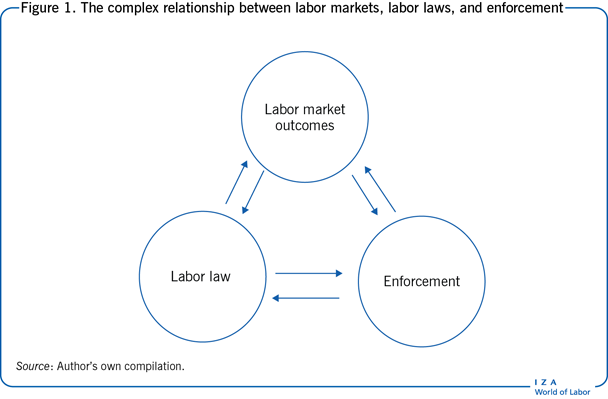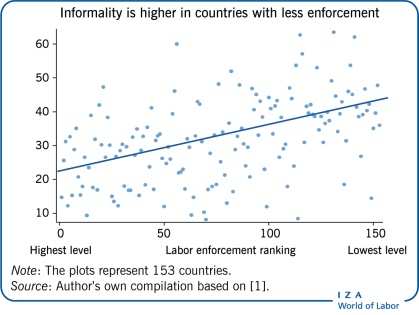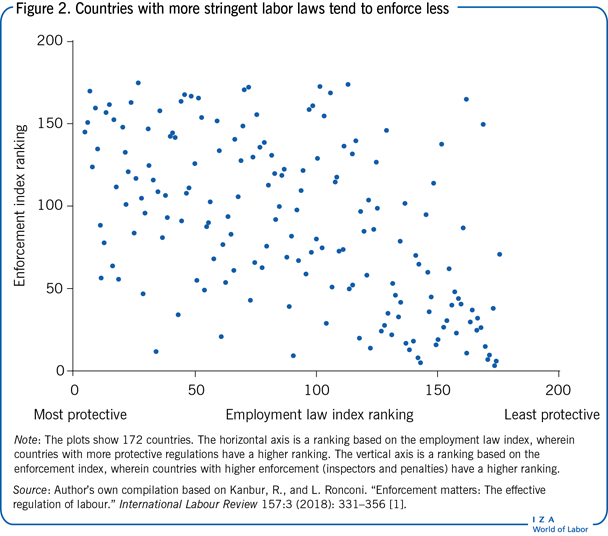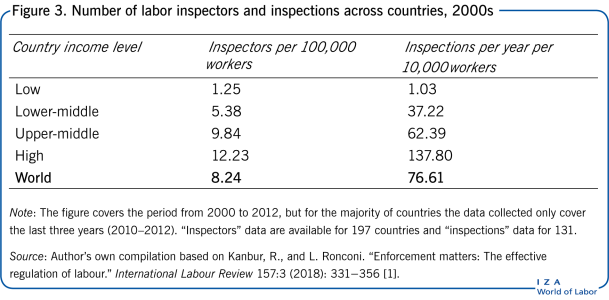Elevator pitch
More than half of private sector employees in the developing world do not receive legally mandated labor benefits. These regulations have typically been enacted by democratically elected governments, and are valued by both formal and informal workers. Increasing public enforcement (e.g. inspections, fines, and workers’ access to the judiciary) can be a powerful tool to reduce violations (e.g. increase the number of employees earning above the minimum wage). Which factors determine enforcement, and whether enforcement produces more social benefits than costs, are, however, unanswered questions.
Key findings
Pros
Enforcement reduces violations of labor regulations, improving the rule of law.
Workers who have access to legally mandated benefits are more likely to trust the state, and hence, to comply with their civic duties.
When labor regulations are adequate, enforcement can increase efficiency, thereby reducing market failures, leveling the playing field, reducing work-related injuries, and improving the income distribution.
Cons
Labor inspectors can be corrupted by lobby groups, particularly in countries that lack an autonomous civil service.
Enforcement can be politicized in countries that lack constraints on presidential power, serving as a tool to reward political allies and punish enemies.
When labor regulations are inadequate, enforcement can destroy productive employment and investment, particularly among low-skilled workers in small firms.
Author's main message
More public enforcement can help reduce violations of labor regulations. Domestic and external factors have been identified in the literature as determinants of public enforcement; but, mainly because of lack of data, there is only partial understanding of the political economy of enforcement in the developing world. Furthermore, the potential simultaneous relationships between de jure labor regulations, enforcement, and economic outcomes is debated with strong opposing opinions and little empirical support. Policymakers have to understand local institutional particularities if they aim to design feasible welfare enhancing policies.
Motivation
Across the less developed world, governments have enacted employment, social security, and occupational health and safety regulations. Those regulations are usually de jure universal, with some notable exceptions such as firm size-based legislation in South Asia. In practice, however, estimates suggest that more than half of private sector employees in the developing world do not receive legally mandated labor benefits due to employer non-compliance. Enforcing labor regulations, however, can be controversial. On the one extreme, non-compliance is viewed as a way to achieve de facto flexibility and economic efficiency in countries where political distortions explain the existence of overly stringent labor laws. On the other extreme, non-compliance is viewed as capitalist abuse of workers and as an impediment to the effective implementation of policies that solve labor market failures.
This article focuses on two key concerns for policymakers in developing countries: first, should governments devote more resources and/or increase fines to enforce existing labor regulations? Are the social benefits of compliance higher than the potential costs of the destruction of informal jobs? Second, which domestic and external factors influence public enforcement? Who are the main actors and institutions, and how do they shape effective labor regulation?
Despite some recent efforts and some interesting findings, the academic literature can only provide partial answers to these broad questions. This is in part due to lack of knowledge about the institutions responsible for enforcing labor regulations; and in part due to the complex relationship between de jure regulations, enforcement, and economic outcomes.
Discussion of pros and cons
Theoretically, quite a lot is known about enforcement of labor regulations. It is clear that the behavior of employers and workers not only depends on the letter of the labor code, but also on its effective implementation. Effective labor regulation (i.e. the combination of de jure regulations and enforcement) can have positive or negative effects on economic outcomes depending on the existence of market failures (e.g. firms with the power to set wages, or incomplete and asymmetric information about occupational hazards). Furthermore, even when market failures are pervasive, government intervention can either improve efficiency or make things worse. That is to say, a reasonably informed policy recommendation cannot be based exclusively on theoretical grounds; it requires country-specific empirical work.
Providing sound empirical evidence, however, is quite challenging. First, it requires quantitative data and institutional knowledge on economic outcomes, labor codes, and government enforcement. Second, to compute a causal effect, the methodology needs to take into account the complex relationship among these three variables. There are reasons to suspect a simultaneous relationship, as shown in Figure 1. For example, not only do employers and workers react to effective regulation, but also legislators introduce reforms to the labor code based on the performance of the labor market and the enforcement system. Furthermore, the institutions in charge of enforcing labor regulations (i.e. labor courts and inspection agencies) might determine their efforts based on the letter of the law, and the performance of the labor market. Finally, effects are likely to differ across labor markets due to variation in institutions and economic structure, making cross-country analysis problematic.

A clear example of the difficulties involved in providing solid empirical evidence can be found in a seminal 2004 study [2]. This influential paper made an important contribution by computing comparable measures of labor regulations across countries; it concluded that more stringent labor regulations have negative economic consequences such as higher unemployment, especially of the young. The evidence, however, suffers an important methodological weakness. Due to lack of enforcement data, the authors only use de jure measures of regulation, which biases the estimates when enforcement and laws are correlated. As shown in Figure 2, there is in fact a negative correlation: countries with more stringent labor laws tend to enforce less. Furthermore, a recent replication study finds that the negative correlation between labor regulation and economic outcomes found in the above work disappears when proxies of enforcement are included in the analysis [1].
Therefore, more research is necessary to make reasonably informed policy recommendations, particularly on the set of institutions in charge of enforcing labor regulations (courts, inspection agencies, and labor unions), and on the complex relationship between economic outcomes and effective labor regulation. The available evidence, however, already provides some useful partial answers.
Inspection resources in countries with a weak civil service
The number of labor inspectors per worker, and particularly the number of inspections, is substantially lower in less developed countries (Figure 3).
Most scholars agree that devoting more resources to an autonomous labor inspectorate, that meets the requirements of a Weberian ideal of a bureaucracy (such as meritocracy), would result in higher compliance. Inspection agencies in developing countries, however, usually do not meet these standards. They are often subject to substantial political interference. This leads to the question: in a weak institutionalized environment, can more inspection resources produce higher compliance? Two studies from 2014 [3] and 2010 [4] analyze the case of Argentina, a federal country where subnational jurisdictions are responsible for enforcing labor regulations. Despite the lack of an autonomous civil service, the evidence suggests that provinces that increase inspection resources and efforts experience fewer labor violations [4]. The 2014 study argues that this is because linkages between bureaucrats and allied civil society organizations (such as labor unions) facilitate routinized resource sharing and the construction of pro-enforcement coalitions [3].
Brazil is another interesting country to study. Since re-democratization in 1985, the labor inspectorate has been subject to substantial reform, leading to major improvements thanks to higher professionalization [5]. A 2012 study explores variation in labor inspections across municipalities in Brazil and also finds that a rise in inspections produces an increase in compliance with labor regulations, although at the cost of higher unemployment [6]. Empirical studies from Peru and South Africa, however, do not find a statistically significant relationship between labor inspections and compliance.
Enforcement and efficiency
Some empirical studies suggest that enforcing stringent employment regulations reduces efficiency. For example, one recent study finds that increased enforcement in Brazil limits the plant-level productivity gains associated with a more global market [7]. Along the same lines, an earlier work exploits variation in labor inspection across Russian states and finds that strict enforcement suppresses labor demand [8]. Other studies, however, find positive economic effects. The 2008 study on Brazil, for instance, shows that labor inspectors have been able to improve workers’ rights without harming firms’ competitiveness (and in some cases, even enhancing it) [5]. And a 2015 study finds that a national campaign for minimum wages, implemented by the government of Costa Rica in 2010, produced higher compliance with minimum wages and other legally mandated workers’ benefits without reducing employment [9].
These contrasting results raise the question: why does more labor inspection have positive impacts in some cases but negative impacts in others? The literature provides two types of interpretation. The first interpretation, usually held by economists, stresses the presence (or not) of market failures. Finding that more inspections reduce efficiency is interpreted as evidence that the neoclassical model is an accurate description of the labor market. On the other hand, finding that more inspections improve efficiency is interpreted as evidence of important failures in the labor market (such as monopsony, that is, too much power among employers). The second interpretation, usually held by other social scientists, emphasizes differences in inspection styles. This school of thought assumes that in the developing world many firms are not well informed about labor regulations and, in some cases, are not maximizing profits. Following a strict punitive enforcement style in these cases can lead to resentment and unwillingness to cooperate.
By contrast, if the labor inspector follows a more pedagogical style, it could achieve both higher compliance and firm productivity. Once again going back to the 2008 study on Brazil, the author argues that a combined enforcement strategy (where inspectors have discretion to decide whether to apply fines or offer education/assistance) “allow[s] labor inspectors to learn about the obstacles preventing firms from complying with the law and to develop innovative local solutions. These compliance solutions include technological improvements, adaptations of the regulation to local/industry circumstances, and the sorting out of unnecessary, costly and inapplicable bureaucratic requirements from relevant institutions protecting workers and organizing markets” [5]. That is, a holistic perspective that properly combines coercive and pedagogical enforcement strategies can improve both compliance with workers’ rights and firms’ productivity [10]. Providing inspectors with discretion, however, introduces the opportunity for corruption, an issue that does not yet seem to have been studied.
Compliance with workers’ rights can promote civic responsibilities
Recent research shows that non-compliance with labor law can have important social costs. Evidence suggests that some workers in Latin American countries who do not receive the labor benefits to which they are legally entitled are often alienated—not only from their employer—but also from the state. They believe that the state did not protect their rights, and reciprocate by not complying with their civic duties (e.g. voting and paying taxes). That is, employer non-compliance with labor legislation erodes workers’ likelihood of fulfilling their citizenship responsibilities. This result is important for policymakers. Either achieving de facto (instead of de jure) labor market flexibility by turning a blind eye to employer non-compliance, or enacting employment protection legislation, but then failing to devote sufficient resources to enforcement, produces more social costs than previously thought. The large gap between the written intent of the law and actual labor practices that is so pervasive in less developed countries contributes to the erosion of civic responsibilities [11].
Demand for labor regulation
The large majority of workers in the developing world (either formal or informal, employed or unemployed) express their support for protective employment regulations. Furthermore, protective labor codes have usually been enacted by democratically elected governments. Increasing compliance is thus necessary to respect citizens’ preferences, and a key instrument to achieve this objective is enforcement.
Labor economists usually base their policy recommendations on theoretical insights and empirical estimates of the economic effects of the analyzed policy. The idea is that once the true parameters of the labor market are estimated through careful empirical analysis, then policymakers would be able to design welfare enhancing labor policies. When it comes to labor regulation, in most cases the recommendation is to reduce stringent employment protection regulations or to keep them as they are. It could be argued that, despite much effort, this approach has only achieved partial success, mainly due to difficulties solving the problems of endogeneity that pervade non-experimental studies. An alternative approach is to directly ask voters which labor regulations they prefer. This approach could have some important shortcomings of its own (e.g. some people could report what is socially acceptable instead of what they really prefer), but is nevertheless informative and can complement the more traditional economics literature.
Contrary to the predictions of the insider−outsider model, which indicates that protective labor regulations hurt so-called outsiders (i.e. unemployed and informal workers) [12], the large majority of workers in the developing world, including the outsiders, support protective labor codes. With this in mind, why then do democratically elected governments in the developing world devote such comparatively few resources to enforcing labor regulations if there is such a demand for it? Furthermore, why do they usually devote those few resources to inspecting registered firms, instead of focusing on informal firms where non-compliance with workers’ rights is more likely to occur?
Unfortunately, there does not seem to be a reasonably informed answer to these questions. A potential, and very speculative explanation, is that the costs of inspection take place in the short term (e.g. inspectors’ salaries and informal job destruction) while the benefits take more time to materialize (e.g. better working conditions and rule of law). Because inspection agencies in the developing world are controlled by the executive branch, they have short-term horizons (e.g. the next election) and tend to underinvest in enforcement. This is, however, very speculative. The political economy of labor enforcement is a field with many questions and few answers. One point that does appear clear though is that the low levels of enforcement in the developing world cannot be explained exclusively by resource constraints; withholding sanctions can be the optimal strategy for a politician [13].
Limitations and gaps
There are plenty of shortcomings in the available literature, as mentioned frequently above. An important factor to add to this is the practical difficulties involved in measuring some components of enforcement. In particular, very little is known about the number or size of fines and penalties imposed by labor enforcement agencies in the developing world, nor whether those fines are effectively collected. While fines are conceptually a key variable, there does not seem to be any available study providing this information.
Summary and policy advice
The academic literature has both strengths and limitations when it comes to providing inputs for designing feasible welfare-enhancing labor policies. On the one hand, the literature provides policymakers with a very useful guideline that consists of three central topics. First, policymakers should determine the extent of imperfections in the analyzed labor market. Second, they should consider the preferences of workers and business owners while also identifying key actors and veto players. Third, they should take into account the characteristics of local enforcement institutions. On the other hand, the number of countries and topics that have been studied represents a very small proportion of the affected population. Because there is no “one-size-fits-all” recipe for effective labor regulation, policymakers have to go beyond the academic literature, and understand the local particularities if they are to design feasible welfare enhancing policies.
Acknowledgments
The author thanks an anonymous referee and the IZA World of Labor editors for many helpful suggestions on earlier drafts. Previous work of the author contains a larger number of background references for the material presented here and has been used intensively in all major parts of this article [1], [4], [11].
Competing interests
The IZA World of Labor project is committed to the IZA Code of Conduct. The author declares to have observed the principles outlined in the code.
© Lucas Ronconi


